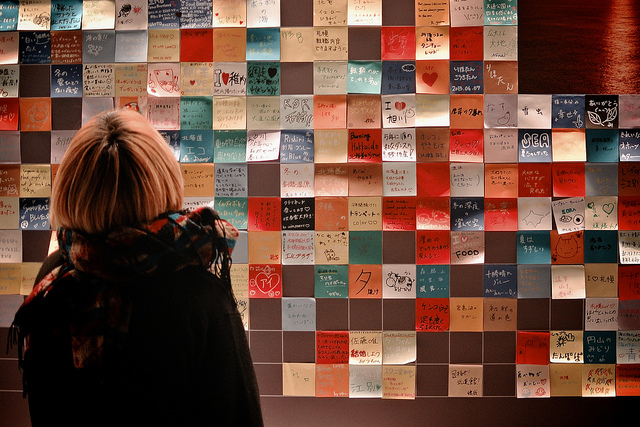
A woman stands before a message board in Sapporo, Hokkaido. Photo © MIKI Yoshihito, licensed Creative Commons Attribution.
It’s easy to fall in love with the sheer beauty of Japan—rugged mountains and coast, subtle changing of seasons, carefully practiced ancient arts, intriguing cuisine, and, of course, the people. From the cold and snowy north to balmy southern islands, you’re never far from volcanoes, hot springs, and the sea. An efficient transportation network makes traveling a pleasure by train, airplane, bus, ferry, or bicycle. You can ski the Japan Alps, stay in a temple in Kyoto, hike the 88 temple pilgrimage in Shikoku, visit pottery villages in Kyushu, and swim Okinawa’s coral seas. During my 25 years in Japan, I have photographed wildflowers on northernmost Rebun Island in view of Russia’s Sakhalin Island, watched salmon spawn in rushing rivers, cycled over steaming volcanoes, and climbed 12,388-foot Mount Fuji to watch the sun rise over the Pacific. Whether you plan to study, teach, seek a corporate job, or start your own business, unlike a passing tourist you will have time to delve deeply into your areas of interest.But Japan in the 21st century is also a modern consumer society with every convenience yen can buy. As a first-time visitor, judging by the fast food, fashions, and fads, you may think Japan completely Westernized. You might wonder, “Where are the kimonos, samurai, and geisha?” The fact is, contemporary Japanese culture is a comfortable, seamless blend of wa (Japanese), yo (Western), and other cultural influences. This is not surprising if you consider that Japanese have been eating pan (bread) and castella (sponge cake) since Portuguese ships landed in 1543, and playing baseball with a passion since it was introduced by an American teacher in 1871. Even their writing system combines Chinese kanji characters, Japanese kana symbols, and the Latin alphabet.In Japan you can wear your hair black or bleached blond, wear jeans or yukata (cotton kimono), sip a latte or matcha (powdered green tea), eat French pastries, Chinese noodles, or squid pizza. You can play golf or practice kendo (fencing), go to the opera or Kabuki (traditional theater), and watch the Giants or sumo from your sofa or tatami mats. After a day of hiking or snowboarding, you can soak in a rotenburo (outdoor spa) and collapse onto your futon or bed.
Whether you plan to study, teach, seek a corporate job, or start your own business, unlike a passing tourist you will have time to delve deeply into your areas of interest. You can observe how Japanese traditions and history are reflected in daily life, how family and respect for others are cultivated, how teamwork is valued from preschool to adulthood, and how persistence and gambaru (trying hard) are often emphasized over innate ability.
With so many choices, how do you choose where to live? Urban or rural, mountains or coast, traditional or high-tech, north or south? In my case, eastern Hokkaido was where I formed my identity, in a small town among dairy farms, my missionary parents and siblings the only Americans around. In my teens, I moved to Sapporo, Hokkaido’s capital, and then Tokyo, to attend American schools. As an adult I returned to Hokkaido to teach at a university and, more recently, went back to Tokyo for three years to research Japanese education. While I love Tokyo’s fast pace and infinite choices for restaurants, shops, movies, museums, parks, and rivers, the mountains and plains of Hokkaido are still my kokoro no furusato (home of the heart).
Excerpted from the Third Edition of Moon Living Abroad in Japan.